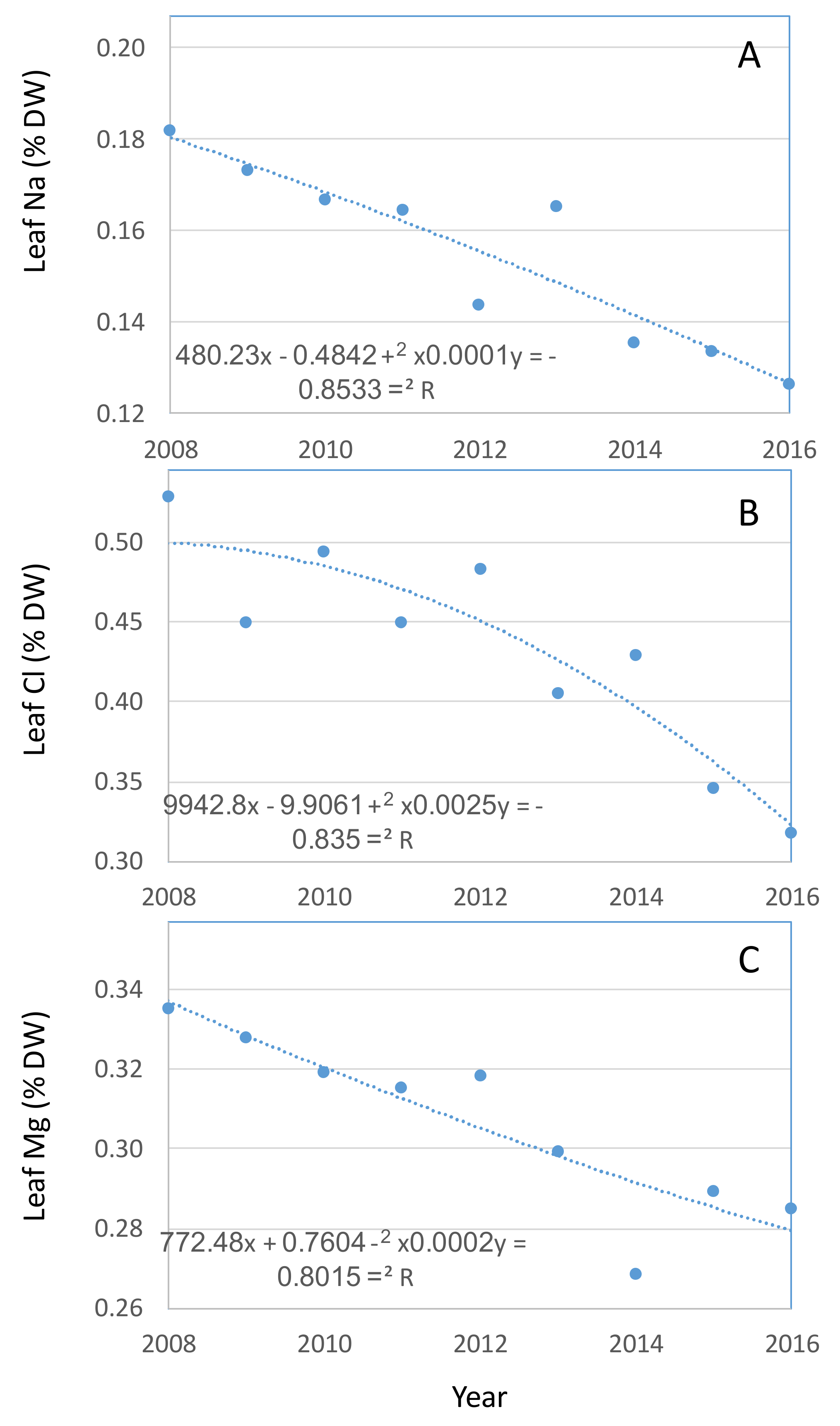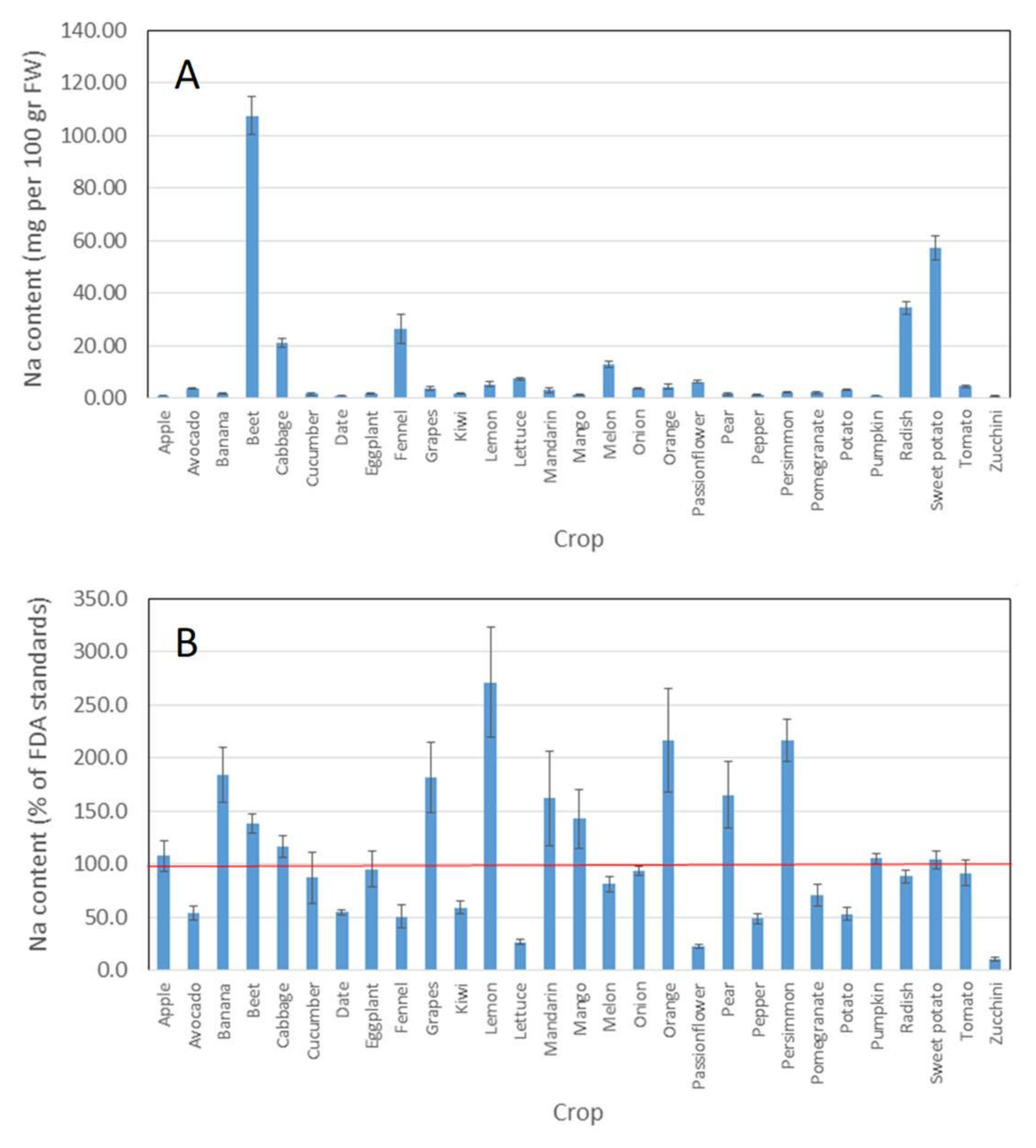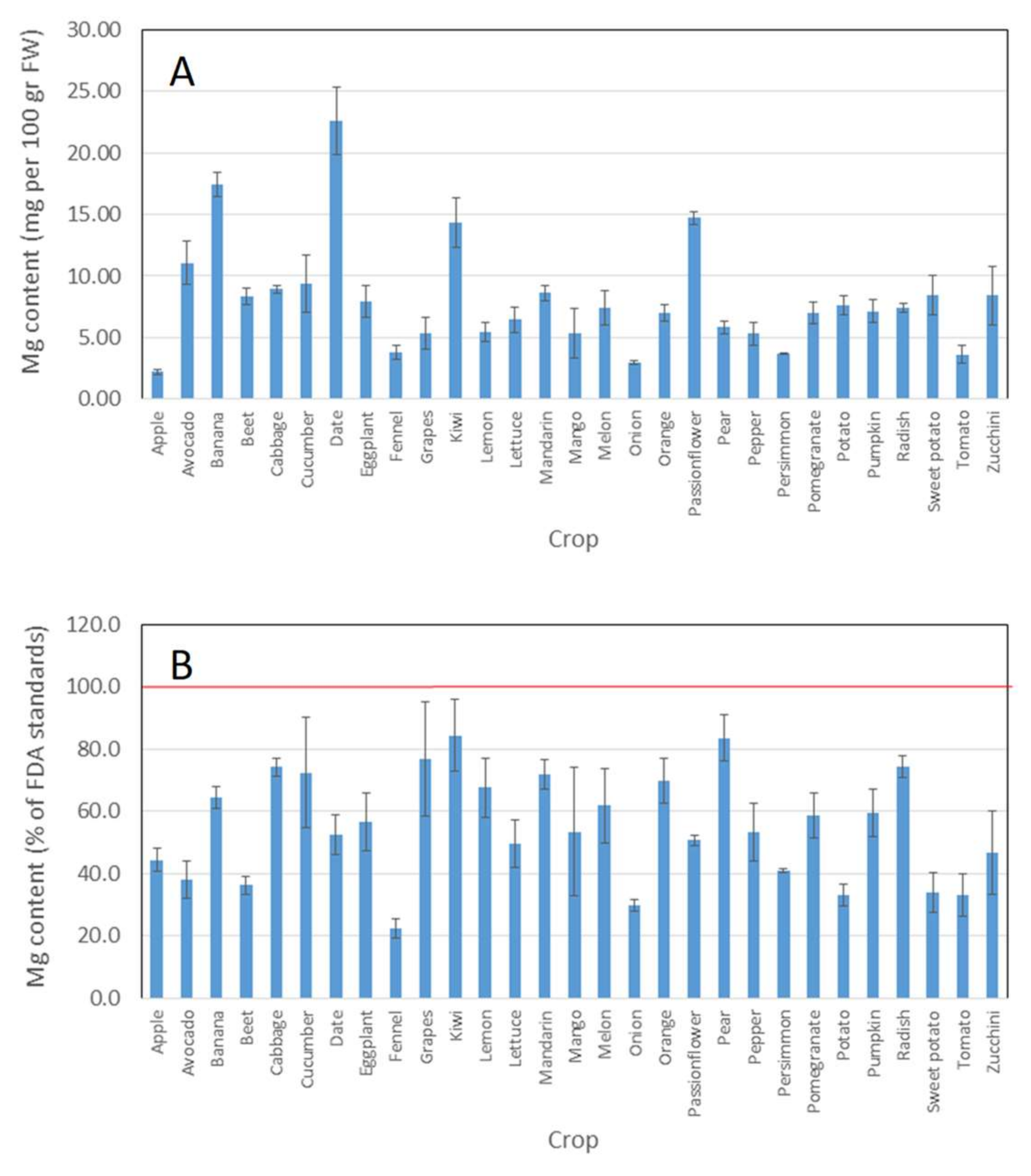1. Introduction
It is generally acknowledged that providing global growing needs for food, fiber, and bio-energy necessitates expansion of agriculture into the world’s more arid regions. The hot and dry nature of such regions slated for increased agricultural activity themselves necessitate irrigation to allow production. Water-scarcity in the dry areas of the world, in turn, has led to utilization of non-conventional water sources for irrigation. Moreover, these water sources, namely recycled wastewater and brackish groundwater, are characterized by high levels of minerals and contaminants, almost universally including problematic salts.
Salts in irrigation water reduce a crop’s ability to take up water and, via combinations of osmotic and toxic stresses, inhibit growth and production [
1,
2]. Farmers irrigating with water containing problematic salts must insure at least periodic leaching of the soil where roots are active to enable sufficient plant health for successful agricultural production [
3]. Contrary to wetter areas, in dry regions, rainfall and natural hydrologic systems are insufficient to remove added salts and, after leaching the root zone, deeper soils and groundwater are contaminated with accumulating salinity [
4,
5].
Due to the basic need for leaching and the nature of arid ecosystems, irrigation with water high in salts in such regions is fundamentally not sustainable [
6,
7,
8]. Rising saline groundwater tables, resulting from excess irrigation allowing continued irrigation and production, has been the ruin of civilizations in drylands throughout human history [
9]. Tales of ruined civilization linked to this narrative have been repeated throughout history, from Mesopotamia to the Indus Basin, and continue to be part of the dialogue in locations including California, Australia, and Pakistan. Modern strategies for coping with the phenomenon often include costly and complicated systems for collection and disposal of drainage water from the irrigated agricultural areas [
10].
In Israel, the story has taken a markedly different and unique turn. Most of Israel has deep soils and deeper aquifers, and therefore rising water tables are not an issue. Nevertheless, Israel has been a pioneer of a combination of highly efficient delivery of irrigation water via drip systems on one hand, and large-scale utilization of relative salty water sources for irrigation on the other [
8]. Between 1970 and 2004, irrigation water to Israel’s agriculture moved from being dominated by fresh water to almost 50% irrigation with saltier water, mainly as recycled municipal wastewater [
11]. Almost simultaneously, Israel developed and moved from surface and sprinkler irrigation to the more efficient drip technologies and methods [
8]. Unique to the world, Israel’s adoption of drip came early and was nearly absolute and today all irrigation is via pressurized sprinkler and drip systems with the latter covering about 80% of Israel’s irrigated land. Between the 1970s and the early 2000s, Israeli irrigation was thereby characterized by concurrent movement towards: (a) use of non-conventional water high in salts; (b) efficient irrigation due to drip and smart, data driven (meteorology plus crop factors, water status monitoring, etc.), scheduling; (c) pricing to enable/encourage application of water for leaching; and (d) leaching of salts leading to contamination of groundwater with salts and nitrates.
The ramifications of these actions were investigated in a previous study [
7] focusing on national trends between during the period of utilization of recycled wastewater and adoption of drip irrigation. An evaluation of national scale historical data to define trends in Israeli soils and citrus leaves revealed increasing salinity over time (mid 1990s until early 2010s). The sodium (Na) fraction of cations in soils was shown to increase 50% over the course of period for which data was collected. Sodium and chloride (Cl) in diagnostic leaves of citrus trees both doubled over the same period. Additionally, Na in Israel’s then current (2012) fresh produce was found to be well over USA standards. In a comparison of values found in a large sample of 24 fresh, edible products (crops) sampled from farms and markets from all over Israel, 20 were found to have higher Na compared to USDA reported standard values. Some of the produce reached levels four to five times those expected according to the US database. For example, oranges in Israel were found to have around 4 mg/100 g fresh weight which is some five times greater than the level reported as normal or expected in the US.
However, Israel’s story does not end there. Since 2007, Israel has addressed water scarcity by adding seawater desalination into its water budget and has done so massively. As of 2010, more than 40% of Israel’s fresh water supply has moved from surface and groundwater sources, all with some component of salinity, to desalinated water essentially void of salts [
12]. The repercussions of such large-scale movement from lower to higher quality water to the overall hydraulic and hydrological systems in the country are multifaceted. First, the quality of fresh water has changed, with significantly less salts reaching the 50% of irrigated agriculture using Israel’s national water carrier as a supply. The move to desalinated water was naturally received positively by farmers realizing potentially higher yields with less water and opportunity for increased water and fertilizer efficiency [
6]. Management of desalinated water for irrigation proved to come with its own set of challenges though, most particularly following the realization for need to supply minerals such as calcium (Ca), magnesium (Mg), and sulfate (SO
4) that had traditionally been components of delivered water but are not present in the desalinated water [
13]. An additional important ramification of the desalination of municipal water supply was the decreased salinity in the wastewater stream and significant lowering of salts in recycled effluent used for irrigation [
14].
Post-desalination era irrigation water in Israel indeed has significantly less salts than previously was the case. Mineral content of both tap water and effluent of course vary widely over time and especially by location, depending on variables including original water source and treatment methods. The following numbers are therefore very general but should provide a fairly reliable comparison of irrigation water quality in Israel pre- and post-large scale desalination of sea water. Pre-desalination tap water supplied by Israel’s national water carrier would typically have 60–100 mg/L Na, 50–70 mg/L Ca, 5–10 mg/L K, 25–30 mg/L Mg, and 200–220 mg/L Cl with electrical conductivity (EC) of around 1 dS/m. Today, with the addition of desalinated water containing low to no concentrations of these minerals, tap water is better characterized by 10–30 mg/L Na, 30–45 mg/L Ca, 0–4 mg/L K, 0–10 mg/L Mg, and 40–140 mg/L Cl, with EC of 0.2–0.5 dS/m [
13,
14,
15]. The salinity and character of municipal wastewater effluent after treatment is largely a function of local background tap water quality plus typical additional concentrations of 70–80 mg/L Na, 100–120 mg/L Cl, 25–40 mg/L K, and only ~10 mg/L Ca and Mg. As a result of the influx of desalinated water to municipal supplies, Na in effluent from recycled municipal wastewater has roughly decreased from over 150 mg/L to under 150 mg/L, Mg from more than 40 mg/L to under 15 mg/L, K from as much as over 40 to under 30 mg/L, and Cl from over 300 mg/L to under 220 mg/L [
14,
16,
17].
The driving hypothesis of this study is that the move to desalination would reverse prior problematic trends of salinization in Israel and provide a path to sustainable irrigated agriculture. Our objective therefore was to evaluate effects of desalination in Israel on the status of salinity trends. To do this, we revisited the original approach of using a national macro-data set by reevaluating citrus leaf Na and Cl from 2008 until 2015. We additionally took new samples of edible crops and reevaluated their Na concentration compared to USDA standards. Since desalinated water in Israel is universally devoid of the mineral magnesium, the trends of Mg since 2007 in citrus leaves and its concentration in fresh produce were evaluated as well.
2. Materials and Methods
To explore trends in Na and Mg levels in citrus, we investigated a database summarizing ~13,500 citrus leaf samples collected by Israeli growers between 2008 and 2016 and sent to national laboratories for mineral analysis. Samples, tested for Na, Cl, and Mg concentrations, were typically taken in October–November from around four to six month old ‘diagnostic’ leaves from fruiting branches. List of varieties and orchard location included in the database can be found in Raveh (2013) [
18]. The database was received from the Israeli Field Services Laboratories and included samples from commercial citrus orchards from all over the country; about 42% of the analyses came from orchards located along the coastal area of Israel, another 31% from the western Negev, and about 27% from the north of the country. For Mg analysis, leaves were washed in distilled water, dry ashed, extracted with HCl and analyzed by ICP (Spectrociros ccd, Spectro Analytical Instruments, Kleve, Germany). For Na and Cl analysis, the washed leaves were oven dried at 65 °C for 72 h, pulverized and analyzed using water extract [
19]. The database included samples from all parts of the country. Since growers may not routinely request leaf Na and Cl analysis for orchards that appear healthy, it is likely that the mean values found over the years in the databases do not necessarily represent absolute mean nationwide values. Assuming that the samples represent more problematic areas than not, the values for all of the parameters tested are likely to be higher than actual averages. Leaf salt concentrations could also be influenced by differing or changing meteorological conditions. While actual annual rainfall in Israel fluctuates widely, during the period that the samples were taken the average annual rainfall was 8.6% below the long-term yearly average [
20].
In order to assess a more current picture of the effects of desalination water on Israeli agriculture, 550 samples of 29 different fruits and vegetables (20–25 samples of each product) were acquired from all over Israel during 2017. The edible part (2 to 4 g) of each product was dry ashed (550 °C), extracted with HCl (18.5%), and analyzed for Na and Mg concentrations by atomic absorption spectrometer (Pinaacle 500; PerkinElmer, Waltham, MA, USA).
The Na and Mg in Israeli crops was compared to that found in the USDA National Nutrient Database for Standard Reference Food and Drug Administration [
21].
3. Results and Discussion
Annual levels of Na, expressed as percentage of dry weight (% DW), in leaves of citrus trees have steadily and linearly decreased by some 20% from concentrations of over 0.18 to less than 0.14% dry weight since the introduction of large-scale seawater desalination in Israel in 2007 (
Figure 1A). Leaf Cl followed this trend with an even stronger, nearly 35% decline, reducing from over 0.5% in 2008 to 0.34% in 2015 (
Figure 1B). Magnesium in the diagnostic citrus leaves declined nearly 30% as well, from nearly 0.4% in 2008 to 0.28% (
Figure 1C).
Absolute concentrations of Na in sampled fresh produce is shown in
Figure 2A. None of the concentrations reported, even in the root and tuber crops tending to have relatively high levels, are considered dangerous or unhealthy for human consumption. Shown normalized to concentrations expected in the same products in the USA (
Figure 2B), the data reveals that, of the 28 products tested, about a third are very similar to the standards of the USDA, a third significantly higher, and a third lower. The difference between this data and situation in 2017 to the parallel analysis published by [
7] from 2012 is remarkable. In 2012 only 4 of 26 crops were found to have lower Na than US standards and more than half had concentrations of Na more than double the standards.
The move to desalination is expected to be particularly influential on Mg in agricultural systems [
13,
14]. This is supported by the data of Mg in edible products and its comparison with USA standards (
Figure 3A,B). In 2017, Mg concentrations were found to be universally lower in Israeli produce compared to levels in each of the products in the United States found in the USDA database.
Similar to our previous macro-data case study for Israel showing trends over time [
7], the strength of the current data set lies in its indication of large-scale trends and a consequential enabling to rethink big-picture paradigms. Each data set and its statistical consideration could admittedly be questioned, especially since control for uniqueness and balance in sampling is not feasible in such a study. That said, we find the trends and the clear and absolute reversal of the previous findings to be compelling. The fact that negative trends of increasing salinity for more than 20 years were completely reversed following the move to desalination for water supply in Israel is more than promising and indicates hope for sustainable irrigated agriculture beyond Israel and into additional dry areas. The concept and belief that desalination may be a viable strategy instead of irrigation with low quality water is not new [
6,
7,
8,
22], but the new large scale confirming evidence is truly reassuring.
Of course, desalination, as a water supply in general—and for irrigation purposes specifically—is not without issues needing consideration and treatment beyond those of soil and groundwater contamination and management of minerals. The environmental impact of desalination plants, particularly regarding energy consumption and disposal of brines, needs to be addressed in scenarios for long-term sustainability [
23,
24]. This we leave to engineers, designers, and decision makers but are hopeful in the realization that water scarcity today appears to be solvable and expected to become a non-issue as soon as accessible (affordable) sustainable energy will become available. The economics of desalination for irrigation must constantly be evaluated and will be a function of local price scheduling and markets and expected costs and benefits. Today, there is increasing evidence for the economic feasibility for agriculture to support desalination. Examples have recently been shown for Israel [
25], California [
26], Spain [
27], and Australia [
28].







